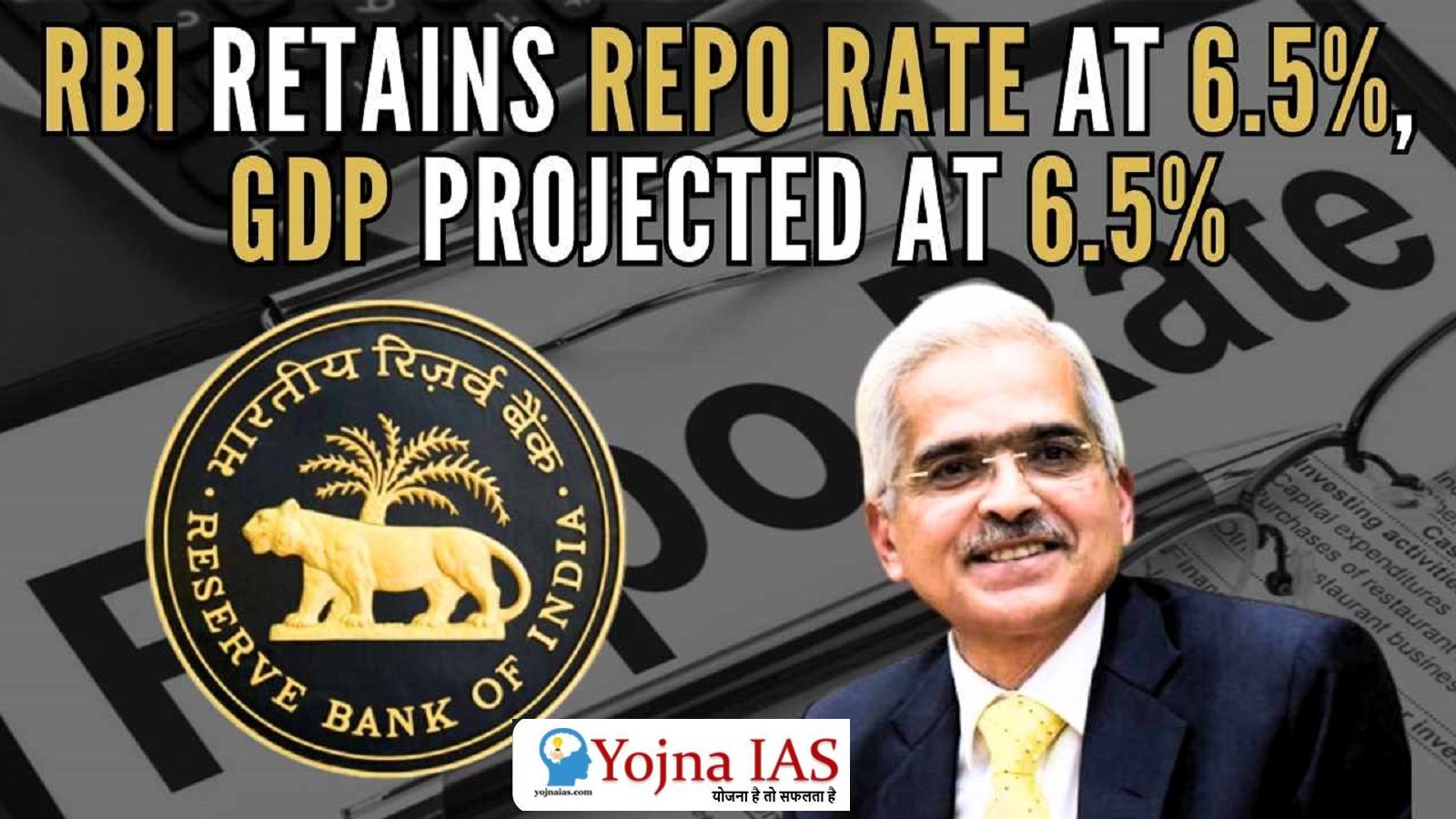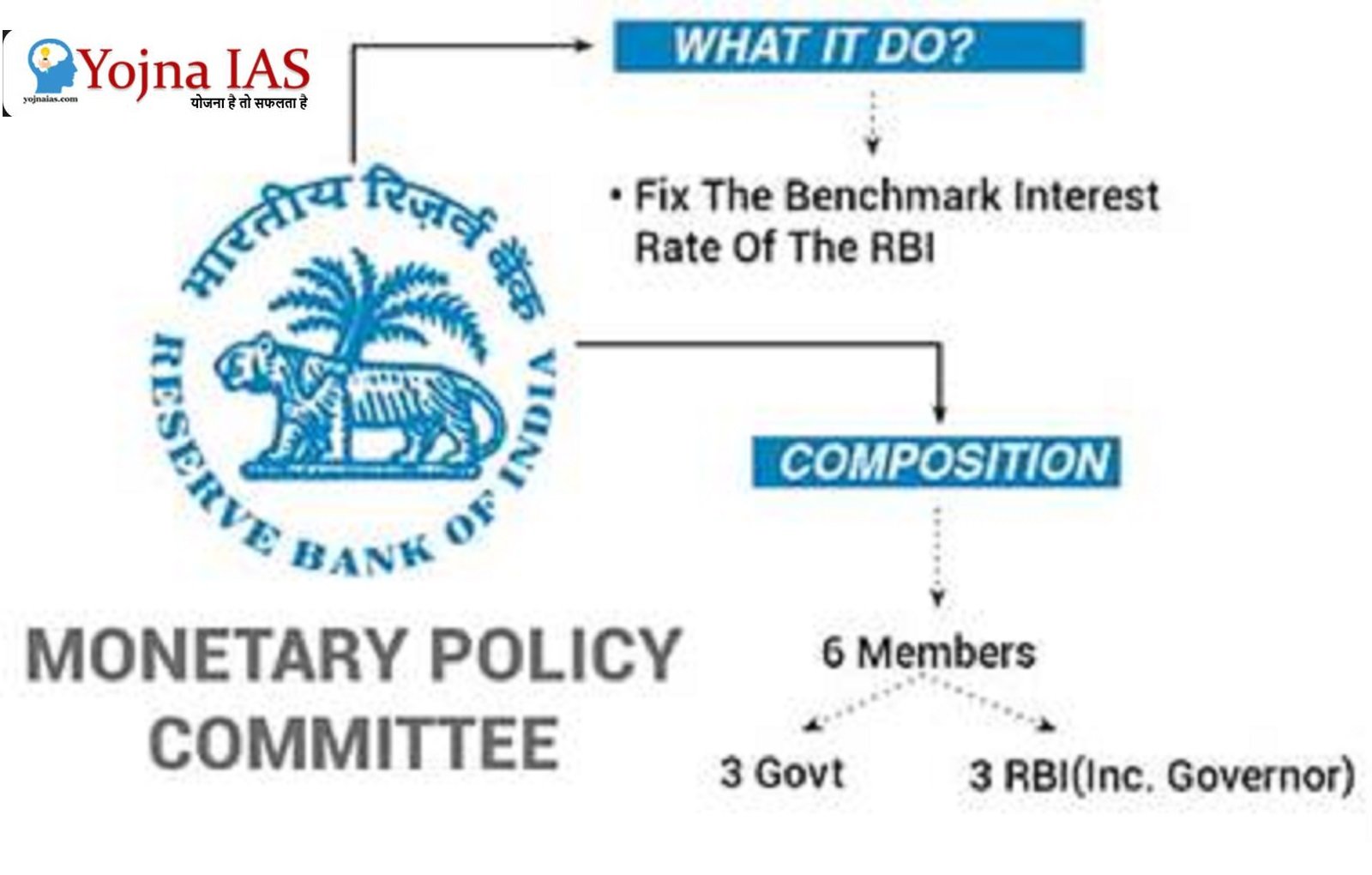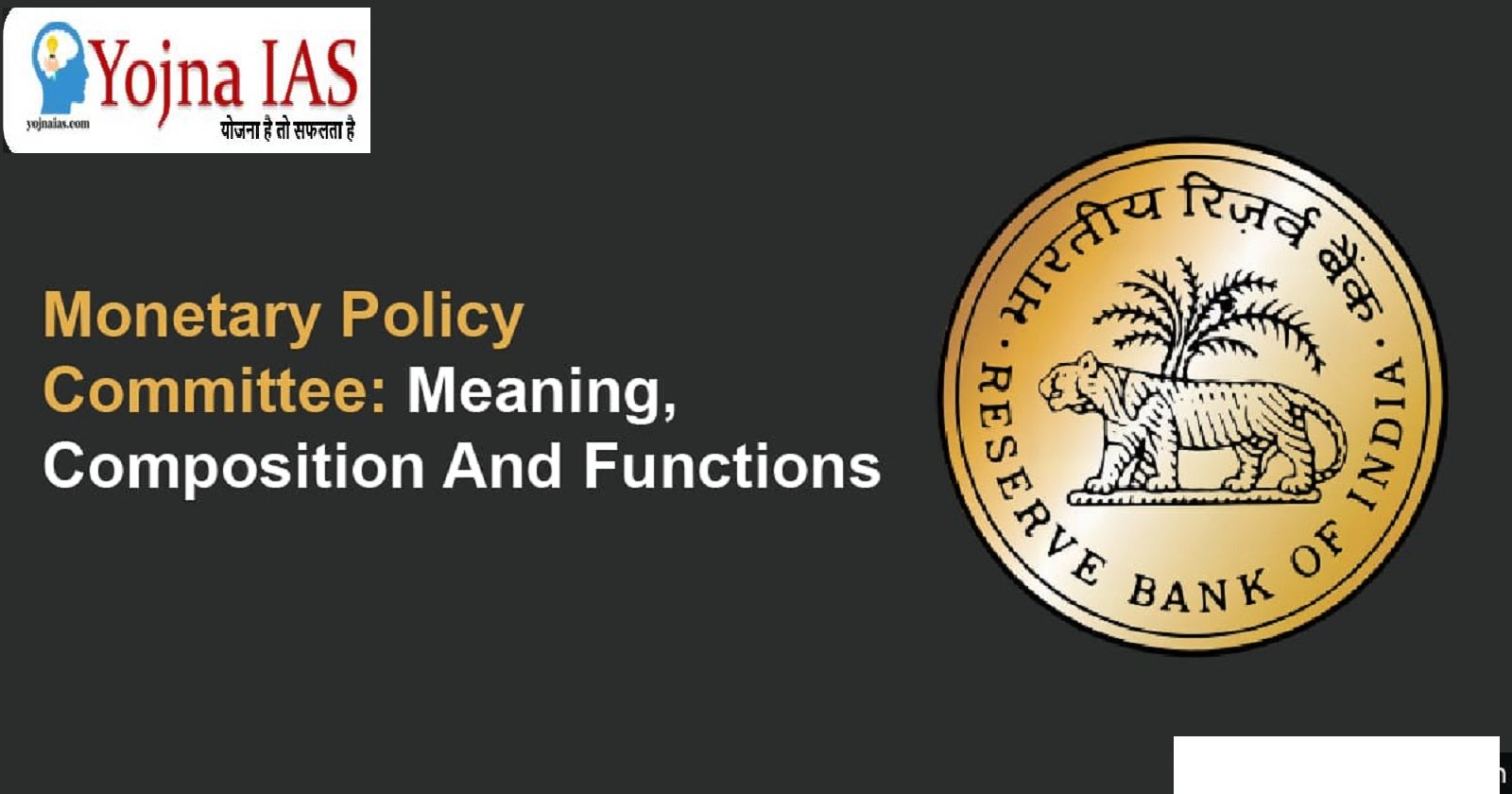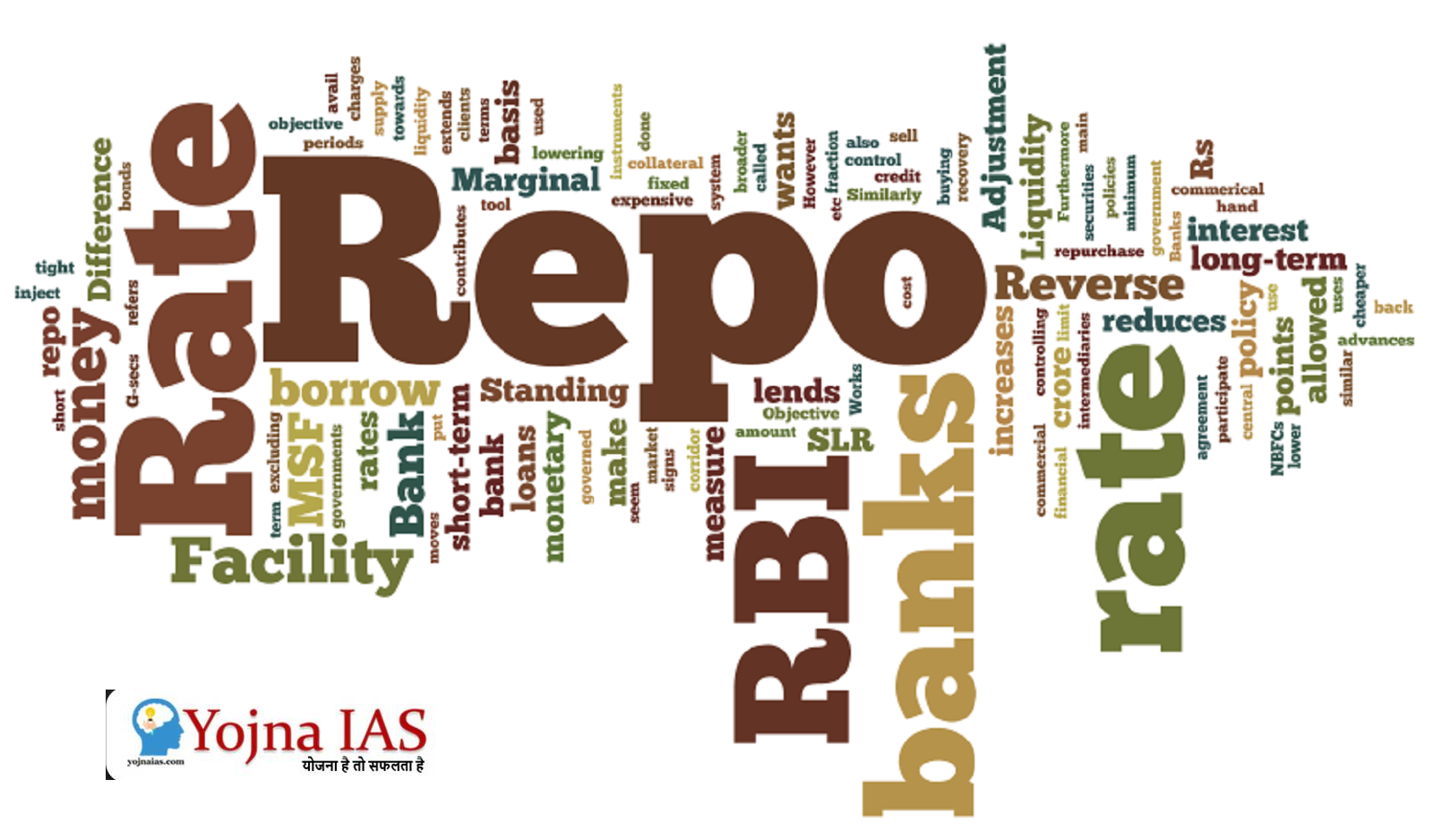08 Apr 2024 Decision regarding repo rate in the meeting of Monetary Policy Committee of Reserve Bank of India
(This article ‘Indian Express’, ‘The Hindu’ ‘Jansatta’ and ‘PIB’ Relates to a brief summary of the included editorial. It also includes suggestions from the Yojna IAS team. This article is related to General Studies Question Paper 3 – Development and Planning of Indian Economy under Main Examination of UPSC Civil Services Examination and Repo Rate, Monetary Policy Committee section under Preliminary Examination. This articleIs related to ‘‘Decision regarding repo rate in the meeting of Monetary Policy Committee of Reserve Bank of India’ under ‘Daily Current Affairs’ )
Why in the News ?

- Recently in India, on April 5, 2024, the Monetary Policy Committee (MPC) of the Reserve Bank of India, in view of the pressure of rising food prices in India, in its meeting has kept the repo rate unchanged at 6.5 percent for the seventh consecutive time.
- The pressure of rising food prices in India is hampering the RBI’s efforts to slow the pace of inflation on a sustainable basis to the target of four per cent.
- In the recently held Monetary Policy Committee meeting of the Reserve Bank of India, the possibility of retail inflation falling below the critical level of four percent in the second quarter (July-September) of the financial year 2024-2025 has also been expressed.
What is the Monetary Policy Committee of the Reserve Bank of India ?

- In India, the Monetary Policy Committee of the Reserve Bank of India is a committee constituted by the Government of India.
- It was formed in the year 2016 to make interest rate determination in India more useful and transparent.
- The Governor of the Reserve Bank is the ex-officio Chairman of the Committee.
- The Reserve Bank of India Act, 1934 (RBI Act) has been amended by the Finance Act, 2016 to provide a statutory and institutional framework in India to the Monetary Policy Committee of the Reserve Bank of India.
- In India, under Section 45ZB of the RBI Act 1934 as amended, the Central Government has the power to constitute a six-member MPC.
- By amending the Reserve Bank of India Act, monetary policy making in India has been handed over to a newly constituted Monetary Policy Committee (MPC).
- Monetary policy is the measure or tool by which the central bank controls the flow of money in the economy by controlling interest rates, maintains price stability and tries to achieve the goal of high growth rate.
- As per the provisions of the Reserve Bank of India Act, out of six members of the Monetary Policy Committee, three members are from the Reserve Bank, including the Governor, a Deputy Governor and one other officer.
- The other three members are appointed by the Central Government. Who are selected by a committee headed by the Cabinet Secretary. Their tenure is of 4 years, and they are not eligible for reappointment.
- It is mandatory to have 4 meetings of the Monetary Policy Committee (MPC) in a year in which the quorum for the meeting is four members.
- Decisions in this committee are taken on the basis of majority and in case of equal votes, the Governor of the Reserve Bank gives his casting vote.
Current members of MPC :
- The Monetary Policy Committee (MPC) has six members, three of whom are from the Reserve Bank of India (RBI) and the other three are eminent economists.
- The members of RBI are Shaktikanta Das (Governor of RBI), Dr. Michael Debabrata Patra (Deputy Governor of RBI), and Rajeev Ranjan (Executive Director of RBI).
- Renowned economists Dr. Jayanti Verma, Dr. Ashima Goyal and Dr. Shashank Bhide.
- As per the RBI Act, the MPC is required to meet at least four times in a financial year. The MPC is chaired by the RBI Governor.
Main functions of Monetary Policy Committee :

- Economic analysis and forecasting : The MPC conducts in-depth analysis and forecasting of various economic indicators, including inflation, GDP growth, employment, fiscal conditions and global economic growth.
- Establishing coordination between inflation target and consumer price index : The current inflation target set by the government is a Consumer Price Index (CPI) inflation target of 4% with a tolerance band of +/- 2%.
- Determining policy interest rates and repo rates in India : The primary function of the MPC is to set policy interest rates, especially the repo rate.
- Critical decision making : Monetary Policy Committee of the Reserve Bank of India in India. The MPC schedules meetings at least four times a year to review the monetary policy stance.
Repo rate :

- The interest rate that the Reserve Bank of India applies to short-term loans given to its customers is called repo rate. Hence repo rate is the interest rate at which commercial banks borrow or borrow money from the Reserve Bank of India.
- In India, the Reserve Bank of India is called the bank of banks.
- The repo rate in India is determined by the Monetary Policy Committee of the Reserve Bank of India.
- Therefore, all the customers of the Reserve Bank in India – banks, central government or state government can get loan from the Reserve Bank of India under the repo rate.
- To avail loans from the Reserve Bank of India, customers have to pledge their government securities with the Reserve Bank of India.
- Banks cannot use the securities held with the Reserve Bank under the Statutory Liquidity Ratio (SLR) to borrow under the repo rate.
Effects arising as a result of increase in repo rate in India :
- An increase in the repo rate in India means that loans will become costlier and the monthly installment of the existing loan will increase.
- In India, increasing the repo rate by the Monetary Policy Committee of the Reserve Bank of India causes banks to borrow less cash from the Reserve Bank, thereby reducing the money supply in the economy and this process is expected to reduce inflation.
- After the increase in repo rate, banks increase the rates of loans like home loan, auto loan, personal loan etc., due to which the expenses of the loan takers increase.
- An increase in repo rate in any economy can affect the consumption and demand of citizens.
Current decisions taken by the Monetary Policy Committee of the Reserve Bank of India :
- In this meeting, it has been decided to keep the repo rate unchanged at 6.5 percent, rejecting any kind of change regarding the repo rate.
- Despite the tightening of liquidity in recent weeks, the RBI has maintained its accommodative policy stance. Holding back housing means reducing the money supply in the economy to control inflation.
- The Monetary Policy Committee of the Reserve Bank of India has retained the GDP growth rate at 7 percent and retail inflation at 4.5 percent for the financial year 2024-25. In February 2024, Consumer Price Index (CPI) inflation stood at 5.09 per cent compared to 5.1 per cent in January 2024.
- Food inflation in India continues to cause considerable instability, hampering the process of disinflation.
- sustained and strong government capital expenditure; Healthy balance sheets of banks and corporates; The outlook for investment activity remains bright due to rising capacity utilization, which is driven by a continuing widening of the private capital expenditure cycle. However, long-standing geopolitical tensions and increasing disruption to trade routes pose risks to the landscape.
- The Indian rupee remained in a range against other currencies of emerging markets and some advanced economies during the financial year 2023-24. This stability would indicate that India’s economy is strong, financially stable and its position in the world market has improved.
New measures currently announced by the Monetary Policy Committee of the Reserve Bank of India :
- Proposal to deposit cash in banks through UPI : Keeping in mind the popularity and convenience of UPI, RBI has proposed to enable UPI for cash deposit facility.
- UPI access proposed for pre-paid instruments (PPI) : To provide greater flexibility to PPI holders, RBI has proposed to allow linking of PPIs through third party UPI applications.
- PPI is a type of financial instrument that allows users to load money onto a prepaid account or card for future use. With this, PPI holders will be able to make UPI payments like bank account holders.
- Currently, UPI payments from bank accounts can be made through the bank’s UPI app by linking the bank account or by using a third-party UPI application. However, the same facility is not available for PPI.
- PPI can currently be used to conduct UPI transactions only using applications provided by the PPI issuer.
- Offers for CBDC through non-bank operators : RBI also decided to distribute Central Bank Digital Currencies (CBDCs) through non-bank payment system operators.
- CBDC is legal tender issued in digital form by a central bank. Digital Rupee (e-Rupee) is a digital currency launched by the RBI.
- RBI has divided the digital rupee into two broad categories:- First general purpose (retail) and second wholesale. This will therefore make CBDC-retail accessible to a wider range of users.
- Proposal to facilitate wider non-resident participation in Sovereign Green Bonds (SGRBs) : RBI is making it easier for non-residents to participate in Sovereign Green Bonds (SGRBs).
- Based on an announcement in the Union Budget for FY 2022-23, the government had released the SGRBs in January 2023. They have decided to allow eligible foreign investors in the International Financial Services Center (IFSC) to invest in these bonds.
- At present, foreign portfolio investors (FPIs) registered with SEBI are permitted to invest in SGRBs under various routes available for investment by FPIs in government securities.
- Introduction of Mobile App for RBI Retail Direct Scheme : RBI has decided to launch a mobile app for its RBI Retail Direct scheme, which was first introduced in November of the year 2021.
- This app will facilitate individual investors to maintain gilt accounts with RBI and invest in government securities.
- A Gilt account is a savings account for government securities, such as treasury bonds.
- It is similar to a bank account but uses government securities instead of cash.
- The scheme allows investors to purchase securities in the primary auction and trade the securities through the NDS-OM platform.
- It was decided to review the Liquidity Coverage Ratio (LCR) framework : Banks included in the LCR framework will have to hold reserves of high quality liquid assets (HQLA) to cover the expected net cash outflow over the next 30 days.
- Some recent developments show that during stressful times, depositors can quickly withdraw or transfer their deposits, especially by using online banking.
- Such emerging risks may require revisiting some decisions under the LCR framework.
- Therefore, certain amendments are being proposed in the LCR framework to facilitate better management of liquidity risk by banks.
Conclusion / Way forward :

- Monetary policy is a set of tools used by a country’s central bank to control the overall money supply and promote economic growth and employ strategies such as modifying interest rates and changing bank reserve requirements.
- Therefore, regarding the economy of India. There cannot and should not be any compromise on price stability.
- According to the monetary policy makers of the Reserve Bank of India, the increase in income of citizens and increase in willingness to spend on non-essential items in the Indian economy is a good sign of strength in private consumption.
- The MPC is much more confident about its economic growth projections in the 12 months to March 2025. Therefore, this year also the GDP is expected to increase by an average of seven percent. For this, many factors are necessary – from the boost in agricultural activities and rural demand due to expectations of normal south-west monsoon to continued momentum in the manufacturing and service sectors.
- The Monetary Policy Committee points out that all five key parameters included in the RBI consumer confidence survey are expected to improve over a one-year period, indicating the Indian economy becoming stronger and growing at a faster pace.
- Therefore, it paves the way for a stronger and brighter future for both India’s economy and India’s Consumer Price Index (CPI).
Source – The Hindu and PIB.
Practice Questions for Preliminary Exam :
Q.1. Consider the following statements regarding the Monetary Policy Committee of the Reserve Bank of India.
- It has been amended by the Finance Act, 2016 of the Reserve Bank of India Act, 1934 (RBI Act).
- The tenure of the members of this committee is 4 years, and they are not eligible for reappointment.
- The Finance Minister of India is the ex-officio chairman of this committee.
- It is mandatory for this committee to hold 6 meetings in a year during any financial year.
Which of the above statement/ statements is/ are correct?
A. Only 1, 2 and 3.
B. Only 2, 3 and 4 only
C. Only 1 and 4 only
D. Only 1 and 2.
Answer – D.
Practice Questions for Main Exam :
Q. 1. Outlining the main functions of the Monetary Policy Committee of the Reserve Bank of India, discuss how low inflation and stable GDP growth in India affects the Indian economy? Give a logical answer.
Qualified Preliminary and Main Examination ( Written ) and Shortlisted for Personality Test (INTERVIEW) three times Of UPSC CIVIL SERVICES EXAMINATION in the year of 2017, 2018 and 2020. Shortlisted for Personality Test (INTERVIEW) of 64th and 67th BPSC CIVIL SERVICES EXAMINATION.
M. A M. Phil and Ph. D From (SLL & CS) JAWAHARLAL NEHRU UNIVERSITY, NEW DELHI.


No Comments